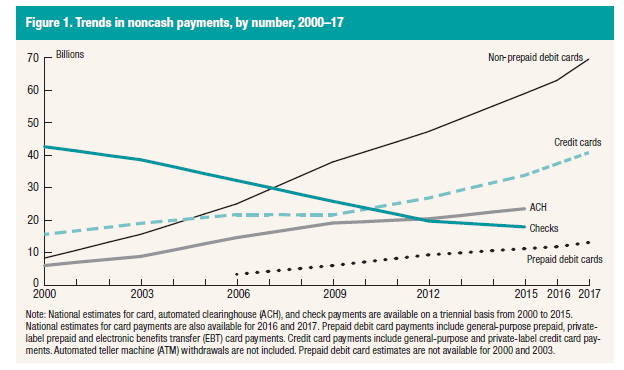Fraud Prevention for Business
Cash may still be king but its dethronement seems imminent as America, and the world, turn increasingly to electronic payments. E-payments, most often requiring the use of a debit or credit card, grew "10.1 percent by number and 8.4 percent by value" from 2016 to 2017, faster than in previous years. Indeed, "since 2016, total card payments—the sum of credit card, non-prepaid debit card, and prepaid debit card payments - increased $0.50 trillion to reach $6.48 trillion by value in 2017." Credit card payments were $3.60 trillion, constituting 55.6 percent of the total value, with prepaid and non-prepaid debit cards making up the balance of $2.88 trillion. The Federal Reserve has published data (Fig. 1) that illustrates the trend of non-cash payments from 2000 to 2017. Increasingly, the preferred method of payment for most Americans is the debit card. Source: Federal Reserve
A large and growing part of electronic payments are related to ecommerce, estimated by the Census Bureau at $512.6 billion in 2018, about 10% percent of total retail sales. These trends are likely to continue as more consumers take advantage of the convenience and ease of shopping online, using their debit and credit cards. Unfortunately, the increased use of debit and credit cards has increased the risk to consumers, merchants, banks and networks from fraud.
Source: Federal Reserve
A large and growing part of electronic payments are related to ecommerce, estimated by the Census Bureau at $512.6 billion in 2018, about 10% percent of total retail sales. These trends are likely to continue as more consumers take advantage of the convenience and ease of shopping online, using their debit and credit cards. Unfortunately, the increased use of debit and credit cards has increased the risk to consumers, merchants, banks and networks from fraud.
Debit and Credit Card Fraud: The Consequences
The chart below shows the extent of debit and credit card fraud in the U.S. over a recent six-year period. Most fraudulent transactions originate as card-not-present (CNP) transactions. However, counterfeit card transactions, which are transactions with fake cards using stolen information, are also substantial. Total losses from debit and credit card fraud amounted to $5.6 billion in 2012. They had climbed by 62.5 percent to reach $9.1 billion by 2018. As alarming as this trend is, the details are more disturbing. While card counterfeit has fallen by around 15 percent in the six-year period, from $2.1-$1.8 billion, CNP fraud has risen by 146 percent, moving from $2.6 billion in 2012 to $6.4 billion by 2018. It gets worse. Value of payment card fraud losses in the United States from 2012 to 2018, by type (in billion U.S. dollars). Source: Statista
As extensive as it is, the scope of card fraud extends beyond unauthorized transactions to dishonest practices such as paying card accounts with checks that bounce and fraudulent requests for a refund or return. Businesses lose revenue and merchandise from these fraudulent chargebacks, while acquirers suffer from the loss of merchant accounts and the reputational damage caused by these data breaches.
There is generally more protection for consumers. Credit cardholders receive protection from losses due to unauthorized use of the card by Regulation Z of the Truth in Lending Act. Those with debit cards have similar protection under Regulation E of the Electronic Fund Transfer Act.
Chargebacks from card-not-present transactions are first paid to the cardholder by the issuing bank, which then recovers the funds from the acquiring bank. The issuing bank is the consumer's bank, which issues the card on behalf of one of the card networks (Visa, MasterCard, Discover, etc.) The acquiring bank is the depositary institution that maintains the business's bank account. Fraudulent chargebacks ultimately end up as losses for the business. However, because banks typically receive chargeback requests weeks after the original payment, it may be difficult for the acquiring bank to recover from the business.
Source: Statista
As extensive as it is, the scope of card fraud extends beyond unauthorized transactions to dishonest practices such as paying card accounts with checks that bounce and fraudulent requests for a refund or return. Businesses lose revenue and merchandise from these fraudulent chargebacks, while acquirers suffer from the loss of merchant accounts and the reputational damage caused by these data breaches.
There is generally more protection for consumers. Credit cardholders receive protection from losses due to unauthorized use of the card by Regulation Z of the Truth in Lending Act. Those with debit cards have similar protection under Regulation E of the Electronic Fund Transfer Act.
Chargebacks from card-not-present transactions are first paid to the cardholder by the issuing bank, which then recovers the funds from the acquiring bank. The issuing bank is the consumer's bank, which issues the card on behalf of one of the card networks (Visa, MasterCard, Discover, etc.) The acquiring bank is the depositary institution that maintains the business's bank account. Fraudulent chargebacks ultimately end up as losses for the business. However, because banks typically receive chargeback requests weeks after the original payment, it may be difficult for the acquiring bank to recover from the business.




